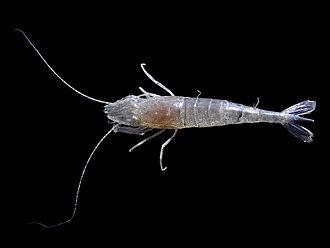Caridea





Caridea is an infraorder of shrimp within the order Decapoda. They are commonly referred to as caridean shrimp or true shrimp. Caridea is a diverse group, with over 3,500 species described, and they are found in a variety of aquatic environments, including both marine and freshwater habitats.
Taxonomy and Classification[edit]
Caridea belongs to the order Decapoda, which also includes crabs, lobsters, and other shrimp-like crustaceans. The infraorder is further divided into several families, including:
- Alpheidae (snapping shrimp)
- Palaemonidae (palaemonid shrimp)
- Hippolytidae (cleaner shrimp)
- Crangonidae (crangonid shrimp)
Morphology[edit]
Caridean shrimp are characterized by their elongated bodies, which are divided into a cephalothorax and an abdomen. They possess a well-developed carapace that covers the cephalothorax, and their bodies are typically laterally compressed. Carideans have ten legs, with the first two pairs often modified into chelae (claws).
Habitat and Distribution[edit]
Caridean shrimp are found in a wide range of habitats, from shallow coastal waters to the deep sea. They inhabit various environments, including coral reefs, mangroves, and freshwater rivers and lakes. Some species are also known to live in symbiotic relationships with other marine organisms, such as anemones and sponges.
Behavior and Ecology[edit]
Caridean shrimp play a crucial role in aquatic ecosystems. They are both predators and scavengers, feeding on a variety of organic matter, including plankton, detritus, and small invertebrates. Many species are also important prey for larger marine animals, such as fish and cephalopods.
Reproduction[edit]
Caridean shrimp exhibit a range of reproductive strategies. Most species are gonochoric, meaning individuals are either male or female. Fertilization is typically internal, and females carry the fertilized eggs on their pleopods (swimming legs) until they hatch into larvae. The larvae undergo several developmental stages before maturing into adults.
Economic Importance[edit]
Caridean shrimp are of significant economic importance, particularly in the aquaculture and fishing industries. Species such as the Pacific white shrimp (Litopenaeus vannamei) and the giant tiger prawn (Penaeus monodon) are extensively farmed for human consumption. Additionally, some caridean shrimp, like the cleaner shrimp, are popular in the aquarium trade.
Conservation[edit]
While many caridean shrimp species are abundant, some are threatened by overfishing, habitat destruction, and environmental changes. Conservation efforts are essential to ensure the sustainability of shrimp populations and the health of aquatic ecosystems.
See Also[edit]
References[edit]
<references group="" responsive="1"></references>
External Links[edit]
Caridea[edit]
-
Heterocarpus ensifer
-
Pandborealis ind
-
Penaeus monodon
Ad. Transform your life with W8MD's Budget GLP-1 injections from $75


W8MD offers a medical weight loss program to lose weight in Philadelphia. Our physician-supervised medical weight loss provides:
- Weight loss injections in NYC (generic and brand names):
- Zepbound / Mounjaro, Wegovy / Ozempic, Saxenda
- Most insurances accepted or discounted self-pay rates. We will obtain insurance prior authorizations if needed.
- Generic GLP1 weight loss injections from $75 for the starting dose.
- Also offer prescription weight loss medications including Phentermine, Qsymia, Diethylpropion, Contrave etc.
NYC weight loss doctor appointmentsNYC weight loss doctor appointments
Start your NYC weight loss journey today at our NYC medical weight loss and Philadelphia medical weight loss clinics.
- Call 718-946-5500 to lose weight in NYC or for medical weight loss in Philadelphia 215-676-2334.
- Tags:NYC medical weight loss, Philadelphia lose weight Zepbound NYC, Budget GLP1 weight loss injections, Wegovy Philadelphia, Wegovy NYC, Philadelphia medical weight loss, Brookly weight loss and Wegovy NYC
|
WikiMD's Wellness Encyclopedia |
| Let Food Be Thy Medicine Medicine Thy Food - Hippocrates |
Medical Disclaimer: WikiMD is not a substitute for professional medical advice. The information on WikiMD is provided as an information resource only, may be incorrect, outdated or misleading, and is not to be used or relied on for any diagnostic or treatment purposes. Please consult your health care provider before making any healthcare decisions or for guidance about a specific medical condition. WikiMD expressly disclaims responsibility, and shall have no liability, for any damages, loss, injury, or liability whatsoever suffered as a result of your reliance on the information contained in this site. By visiting this site you agree to the foregoing terms and conditions, which may from time to time be changed or supplemented by WikiMD. If you do not agree to the foregoing terms and conditions, you should not enter or use this site. See full disclaimer.
Credits:Most images are courtesy of Wikimedia commons, and templates, categories Wikipedia, licensed under CC BY SA or similar.
Translate this page: - East Asian
中文,
日本,
한국어,
South Asian
हिन्दी,
தமிழ்,
తెలుగు,
Urdu,
ಕನ್ನಡ,
Southeast Asian
Indonesian,
Vietnamese,
Thai,
မြန်မာဘာသာ,
বাংলা
European
español,
Deutsch,
français,
Greek,
português do Brasil,
polski,
română,
русский,
Nederlands,
norsk,
svenska,
suomi,
Italian
Middle Eastern & African
عربى,
Turkish,
Persian,
Hebrew,
Afrikaans,
isiZulu,
Kiswahili,
Other
Bulgarian,
Hungarian,
Czech,
Swedish,
മലയാളം,
मराठी,
ਪੰਜਾਬੀ,
ગુજરાતી,
Portuguese,
Ukrainian



